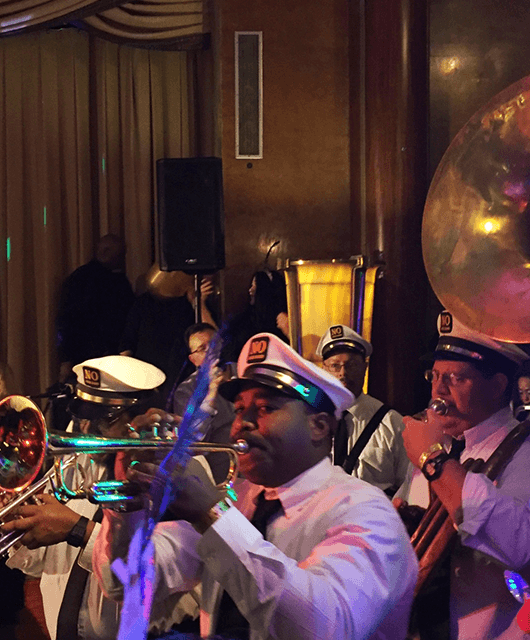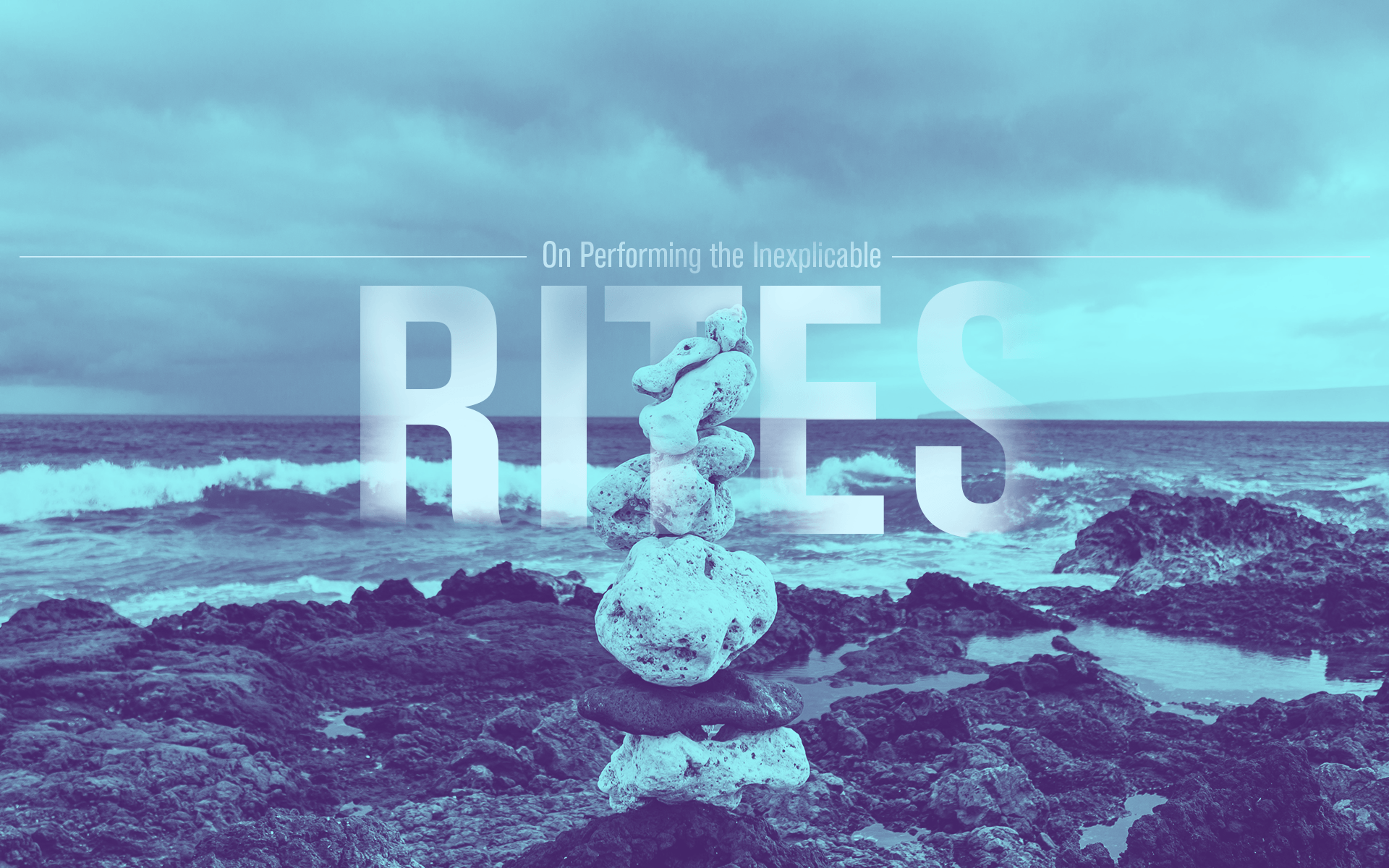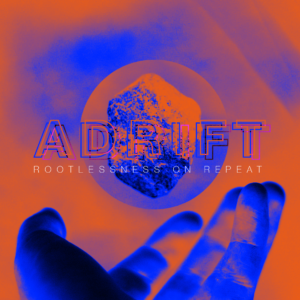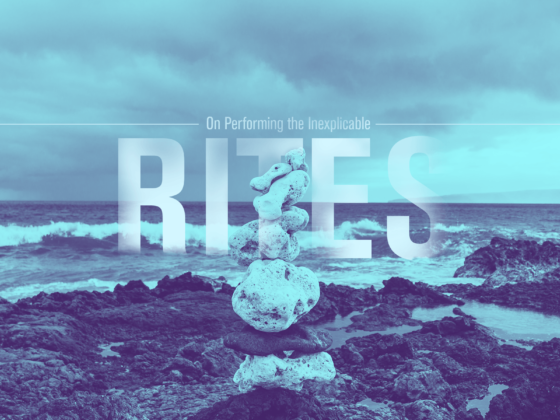ALEXANDRA REALE
It’s a few minutes before the start of the Fourth of July parade in Huntington Beach, California, and the members of the New Orleans Traditional Jazz Band are waiting on Pacific Coast Highway. Surrounding them are old-fashioned T-Birds and Corvettes, high school bands, radio personalities, colorful floats, kids on bikes, scout troops, and parade organizers in red shirts. It’s a noisy affair. Instruments and sunglasses sparkle in the sun as the guys in the band trade stories about past gigs and practice songs from their setlist. These musicians are all diehards; they’ve all been playing since they were very young, and some have plied their craft with acts as famous as Ray Charles, Dizzy Gillespie, Earth, Wind & Fire, and Rose Royce. Many of them can play multiple instruments and are devoted players and teachers. This is their livelihood and their pride and joy. The time arrives for the band to take its place in the lineup, and their director gives the signal. Lifting their horns up, they fall in step, and their big sound immediately fills the air.
Source: floodgateburst/Instagram
Rooted in Tradition

Hilarion Domingue is a talented musician and a shrewd businessman. A native of New Orleans, Louisiana, his musical experience extends from childhood all the way through high school and college, and even took him to war: he played in a military band in Vietnam, after which he set down his instrument for twenty years. He picked it back up in 1995, and shortly thereafter he spotted an opportunity in the Los Angeles music scene, entering sixteen musicians in the 2000 Walk for Breast Cancer in downtown L.A. to bring up the rear playing jazz. They were a total hit, and suddenly he had a band. Over the next few years, he hustled — establishing contacts, sending out flyers, getting the band’s name out, and even putting up a website. They began to get noticed by parade coordinators and laypeople alike, and soon enough Hilarion’s phone was ringing constantly with requests. They began to have regular gigs, and in the first decade of their existence they had firmly established themselves as a band for all kinds of occasions, all throughout Southern California. Everyone wanted the big brass sound of the New Orleans Traditional Jazz Band — they even got a call from Apple. A 2014 iPhone 5S commercial features the band swinging their way through the intro of an old Pixies song.
iPhone 5S Commercial featuring the New Orleans Traditional Jazz Band | Source: Laurie-Anne Collins/YouTube
The N.O. Traditional Jazz Band follows a lineage that finds its roots eponymously: New Orleans is the seat of this style and tradition. The 2005 Billboard Illustrated Encyclopedia of Jazz & Blues devoted a curiously small space to the origin story of jazz bands in this city, but one can nevertheless glean that it is rich and complicated. The place to begin is certainly Congo Square, in the Tremé neighborhood of New Orleans. In the 18th and 19th-centuries this is where slaves were allowed to gather on Sundays, and these gatherings were heavily oriented toward dancing, singing, and drumming. As slavery dissipated from the city and it continued to grow more diverse — with notable Spanish, French, African-American, and American Indian influence — the city’s music and culture took on a life of its own, and it found its roots in those gatherings in Congo Square. In tandem, the work of John Philip Sousa — “the March King” — was proliferating nationwide, and a tradition of marching bands became firmly ensconced in the American parade landscape. Demand grew for brass instruments (trumpets, trombones, tubas, and the like) as marching bands became ubiquitous. Musical New Orleans and its surrounding area were at the forefront: some of the first recorded traditional brass bands include New Orleans’s own Eureka Brass Band, Excelsior Brass Band, and Onward Brass Band, all of whom were active in the late 19th-century and into the twentieth. These were among the first of the “traditional” New Orleans jazz bands.
Source: stephrami/Instagram
New Orleans jazz bands are very animated; they walk with intent like any marching band, but their style, fittingly, encourages improvisation.
What exactly makes a jazz band traditional New Orleans? A band which evinces the sound and style of its Big Easy forebears will generally be fairly small—numbers range from about five to sixteen—and will generally comprise trumpets, trombones, saxophones, a sousaphone, drums (snare and bass, one of which will likely have a cymbal rack attached), and maybe a clarinet. In a parade, the percussion section plays throughout, providing a marching cadence even when the rest of the band is not playing. Once a number is up, the sousaphone joins them in the rhythm section, providing the bass line. If this sounds like any marching band, except smaller, that’s because it essentially is, and you’d be hard-pressed to find a John Philip Sousa march that doesn’t prescribe this exact structure. What sets a jazz band apart is, well, the jazz. The trumpets, trombones, and saxes, bolstered by the relentless rhythm of the tubas and drums, are free to wander away from the bass line, weaving in and out of the melody in creative solos, eventually reversing course and finding their way back. New Orleans jazz bands are very animated; they walk with intent like any marching band, but their style, fittingly, encourages improvisation. Soloists will step away from the rest of the band and dance as they jam, and as their solo ends they’ll be resorbed into the group, which has maintained the pace and melody. Most times the band will have a number of dancers, the so-called “the second line”, for their secondary aspect, floating around its perimeter, moving and dancing to the music, wielding ornate parasols, and in celebratory situations throwing beads to the crowd. In a wedding, the bride and groom will often join the second line, waving white handkerchiefs and dancing to the music.
From LA to L.A.
The New Orleans Traditional Jazz Band, as its name suggests, is a West Coast torchbearer of Big Easy rituals, and so its presence at a parade lends an air of New Orleans authenticity. But it is not just the Mardi Gras or Fourth of July parades where bands like theirs shine: New Orleans jazz bands are professional celebrators of life at all stages, including its end. Hilarion’s band does perhaps its most significant work at funerals, giving voice to grief and providing comfort to mourners. A good band is an elemental part of the New Orleans celebration of life; a funeral of this style without a jazz band is bereft of its heart and soul. The funeral rites of New Orleans Christians are by turns stately and joyful, and it is the music which prescribes and augments the mood.
The New Orleans Traditional Jazz Band performing as part of a New Orleans-style funeral | Source: TheNoJazzBand/YouTube
A typical New Orleans-style funeral, as recounted by one of its members, goes something like this: first there will be a ceremony in a church, where mourners gather to engage in readings and remembrances, and then everyone exits the church to journey on foot to the cemetery, escorting the hearse. In New Orleans, the band typically leads this procession to the gravesite, playing “Just a Closer Walk With Thee” (an extremely famous gospel song, sung notably by Mahalia Jackson), or “Nearer My God to Thee,” while they do a particular kind of walk — left foot out at an angle, right foot catches up, then right foot out at another angle, then left foot catches up — but in a Los Angeles funeral, everyone gets in their cars and drives to the cemetery, where the band will be waiting to lead them in a slow march to the place of rest. When everyone is gathered at the gravesite, and the coffin is readied to be put in the ground, the band strikes up “Amazing Grace,” and whoever wasn’t crying before definitely is now. The priest will say a final blessing, commending the loved one’s spirit to God, and the most somber part of the ceremony is now over. The band will begin playing “When the Saints Go Marching In” or “Down by the Riverside,” both of which are much more uplifting and celebratory pieces of music. The gathered mourners react to this change as if a collective weight has been lifted off their chests: they dance with abandon, lightly, waving handkerchiefs, smiling and laughing. It’s the joy of release — their loved one’s soul has been freed from its earthly body, and they have borne witness to it.
The New Orleans Traditional Jazz Band playing “Down by the Riverside” | Source: notradjazzband/YouTube
Unexpected Clientele
A band that bills itself as New Orleans-bred couldn’t be anything but masterful in something so quintessentially New Orleans as a jazz funeral, and Hilarion’s band has not disappointed. Over the years they have been midwives of grief for countless Southern California families seeking a last link to the Big Easy for their passed loved ones. But an intriguing portion of their identity has been existing quietly, and putting food on the musicians’ tables, for many years, one which does not have its roots in the city along Lake Ponchartrain. When Hilarion was in his early entrepreneurial days of the band, around 2004, he sent out flyers advertising its services to all manner of institutions and communities. One of the groups which responded enthusiastically to his advertising was a Buddhist funeral home in downtown L.A. They had decided not to hire back the band they generally employed for funerals, and were interested in what Hilarion and his New Orleans Traditional Jazz Band had to offer. Hilarion took the gig, and thus began a tradition of a group of mostly African-American and white musicians marching through the streets of Chinatown and Alhambra, playing a mixture of Big Easy classics and Buddhist hymns for mourners of mostly Asian origin.
In the sun-soaked reaches of Southern California, a funerary tradition thrives on the strength of a band whose heritage is steeped in the catharsis that comes from walking with music, something which is clearly not exclusive to one culture or community.
To hear one of these Los Angeles Buddhist funerals described is to assume at first that the question was misheard, and that we are still talking about New Orleans-style funerals. The rites of these two, at least in this one subset in Southern California, are uncannily similar, and it is only a couple of notable exceptions which separate the two. The structure of gathering to remember the deceased person followed by the caravan to the resting place remains the same, but one begins in one of these Los Angeles Buddhist funerals, inside a very white room, with an ornately prepared altar at its focal point. The altar usually includes a large picture of the deceased person, surrounded by flowers, as well food, money, incense, and objects that were meaningful to the person. The band will walk into this space and line up in a straight row, where they’ll play a couple of Buddhist hymns (one common one is called “Long Mi”), and then one of the musicians will step forward and play “Amazing Grace” as a solo, before the rest of the band joins in. Then they all remove their hats and bow three times to the altar before exiting. As the band leaves, a member of the family or someone close to the deceased will hand them a token of appreciation — they’ll get additional money in a red envelope, or if it’s a hot day in L.A., bottles of water. They don’t leave the room empty-handed.
At this point, the musicians — by profession practiced in the art of waiting — typically take a seat in the shade on some nearby benches to await the start of the funeral parade. The remains are loaded into a hearse, the poster of the deceased is placed onto the back of a pickup truck for everyone to see, the mourners get into their cars, and the police shut down the street. Once all the people and cars are lined up, the band stands up and leads a long line of mourners in a joyful procession, playing music all along the way. People lean out their windows to get a look at the parade, tourists and shoppers take pictures and videos, and there is a general feeling of spirit and celebration. The procession almost always passes through the gates of Chinatown on its way to the resting place, and right before the whole party’s arrival at the gates, the band will step out of line to allow the hearse and the mourners to pass by. The musicians cluster on the side of the road, continuing to play, as the deceased’s loved ones, spirits lifted by the music, wave in appreciation.
The New Orleans Traditional Jazz Band performing as part of a Buddhist funeral | Source: Sean Collins Sr/YouTube
If someone asked you to describe a typical American celebration of life, perhaps the first thing out of your mouth would not be “parade.” And yet, in the sun-soaked reaches of Southern California, a funerary tradition thrives on the strength of a band whose heritage is steeped in the catharsis that comes from walking with music, something which is clearly not exclusive to one culture or community. Hilarion estimates that at the peak of the N.O. Traditional Jazz Band’s funereal work, they were doing about twenty Buddhist funerals a year, of about thirty-two total. This is an odd statistic for a jazz band, and immediately invites theorizing. How does a New Orleans jazz band come to be the mitigator of grief for an audience that is part Buddhist, part true blue New Orleans, part miscellaneous? Maybe they were just at the right place at the right time, maybe Hilarion’s natural penchant for entrepreneurship guaranteed them success, or maybe this was just an interesting thing that bubbled up in a diverse city of interacting cultures and communities. It could be something about the transcendence of jazz, and music generally. It might be a lot about the ritual of grief and the part that music plays. Perhaps, like the Southern city which bore it, it’s a little bit of everything.

Once the band was hired for a gig in Simi Valley by a man who wanted to celebrate the life of his mother. They showed up in full regalia, white shirts, black ties, captain’s hats reading “N.O. JAZZ BAND,” instruments at the ready. The man did not ask them to lead a parade or bow to an altar; instead, he had a whole block party set up, and he asked them to play music while friends and family enjoyed the neighborhood, reminiscing, eating, drinking, and laughing together. At one point, the man gathered a whole bunch of balloons up, tied them to a basket, and placed in the basket a single slice of cake. When he let go of the balloons, he said he hoped his mom was enjoying her party, and that she should try the cake. The balloons floated off into the warm air, buoyed by the music of the New Orleans Traditional Jazz Band, and this small and tender gesture was in its own way equal to any parade, New Orleans, Buddhist, or otherwise.

All photos of the New Orleans Traditional Jazz Band are courtesy of the author.





